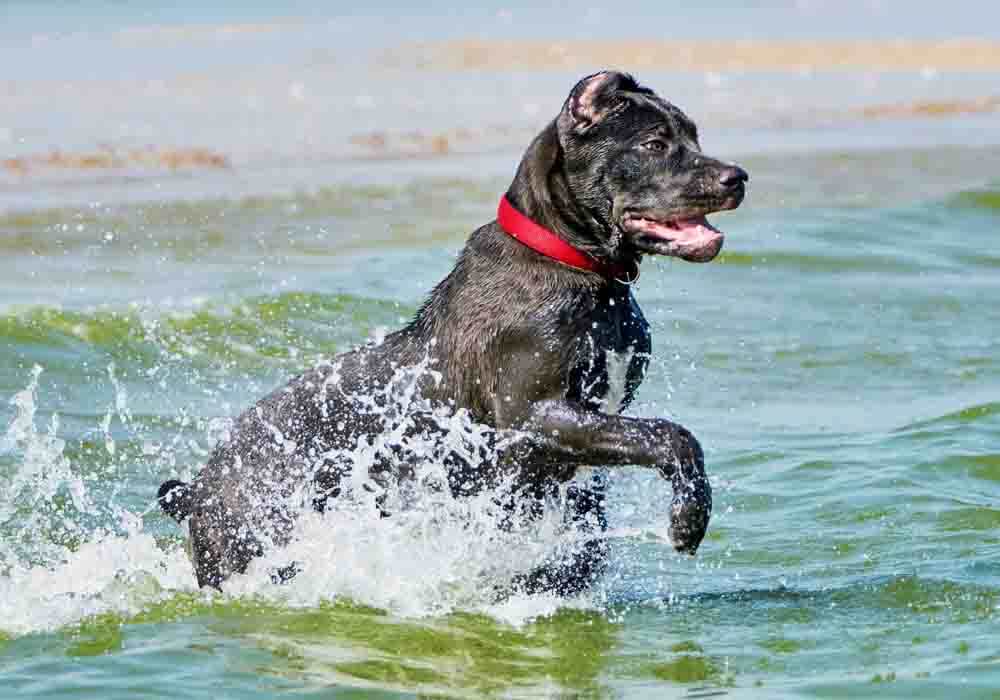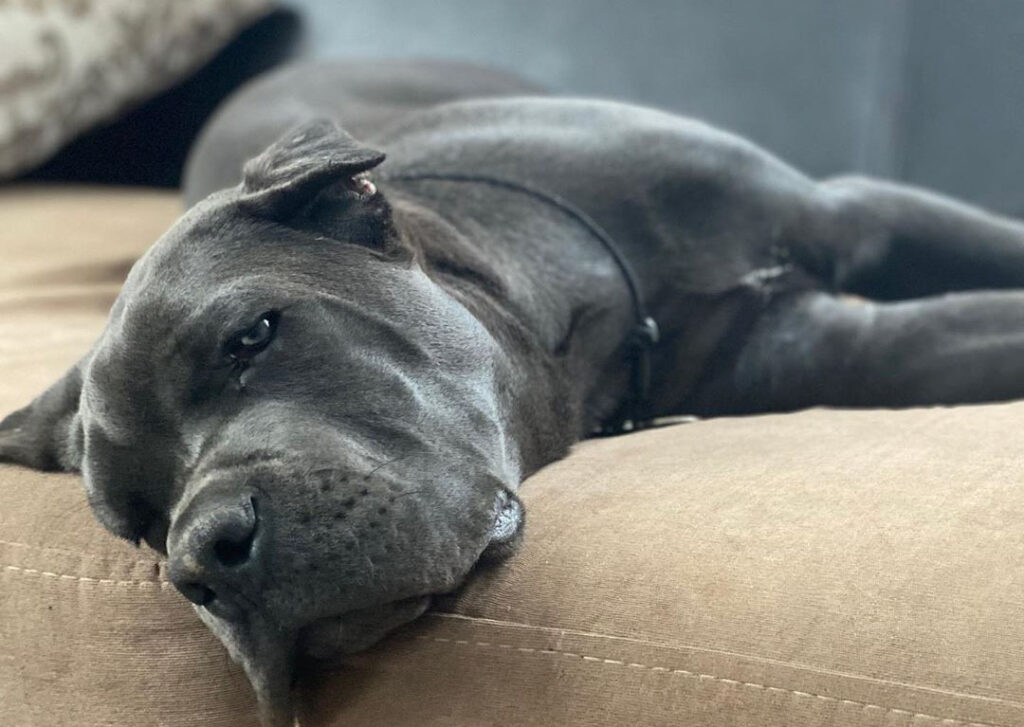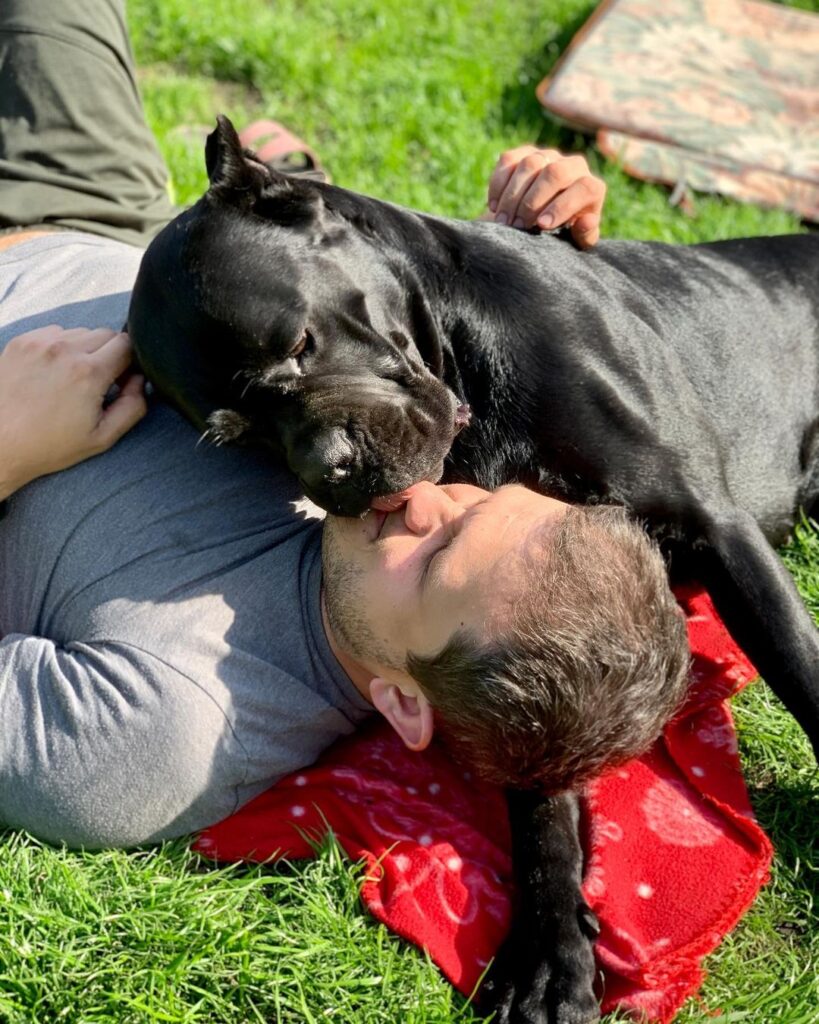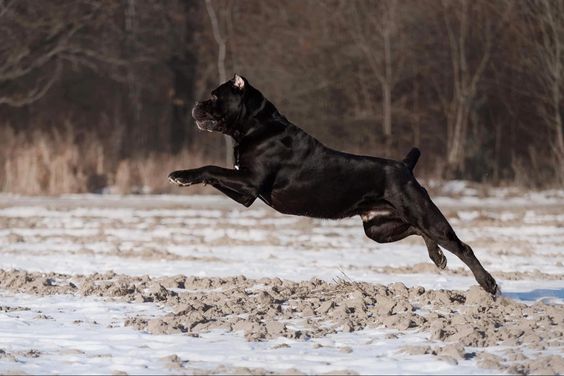
Cane Corsos are powerful and athletic dogs that are known for their agility and strength. A Cane Corso can jump up to 6 feet high. As such, they have the ability to jump considerable heights. Which can sometimes lead to concerns for their safety and the safety of others. In this article, we’ll delve into various aspects related to the jumping behavior of Cane Corsos and provide insights into why they jump, how to prevent jumping-related issues, fence height recommendations, and more.
Why Does a Cane Corso Jump?
Cane Corsos, like many other dog breeds, may jump for a variety of reasons. Understanding these motivations can help address the behavior more effectively. Here are some common reasons why Cane Corsos might jump:
Desire for Exploration and Play
Cane Corsos, with their inherent curiosity and adventurous spirit, often find themselves irresistibly drawn to the prospect of exploration and play. This desire is deeply ingrained in their nature, harking back to their ancestry as working dogs. Picture a Cane Corso’s expressive eyes scanning the horizon, captivated by the sights, sounds, and scents that beckon from beyond. It’s not just about jumping; it’s about seizing the opportunity to uncover the mysteries of the world around them.
For these agile and sturdy canines, jumping serves as a means of elevating their sensory experience. It’s akin to humans climbing a hill to glimpse a breathtaking panorama. In their pursuit of novel stimuli, they may spring over obstacles to reach vantage points that unveil new realms of discovery. Jumping, in this context, becomes an embodiment of their inquisitive nature – a physical manifestation of their unquenchable thirst for exploration.
Seeking Attention
A Cane Corso’s yearning for attention is as heartfelt as it is compelling. These affectionate companions often resort to jumping to secure the focus and affection they crave from their human counterparts. Consider the sight of a Cane Corso gleefully bounding into the air to bridge the gap between itself and its beloved owner. The result is immediate – laughter, pats on the head, and joyful embraces that affirm their significance.
Jumping as an attention-seeking behavior, however, demands a nuanced understanding. It’s a plea for interaction, an attempt to break through the mundane and establish a connection. This underscores the need for alternative ways of engaging with these loyal pets. Redirecting their enthusiasm into calmer modes of interaction, such as sitting or shaking hands, offers a middle ground – a way to balance their desire for attention with appropriate behavior.
Boundary Testing
Boundary testing is where a Cane Corso’s instinctual prowess takes center stage. These canines are descendants of formidable guardian and hunting dogs, known for their vigilance and tenacity. When a Cane Corso jumps to clear a fence or obstacle, it’s often more than just an impulsive act; it’s a demonstration of their ability to navigate and overcome challenges.
Boundary testing also reflects their territorial nature. Jumping allows them to transcend perceived barriers and investigate what lies beyond. A fence that might seem insurmountable becomes an intriguing puzzle that they’re determined to solve. As responsible pet owners, it’s vital to comprehend this behavior and address it thoughtfully. Constructing higher, smoother fences and providing ample mental and physical stimulation within their defined territory can channel their boundary-testing instincts in constructive ways.
How to Avoid a Cane Corso Jumping from a Fence
Preventing a Cane Corso from jumping over a fence is essential to their safety and the safety of others. Here’s how you can address this concern:
Training and Behavioral Modification
When it comes to curbing jumping behaviors in your spirited Cane Corso, training and behavioral modification stand as powerful tools in your arsenal. Imagine your canine companion’s eyes lighting up with understanding as you embark on a journey of shaping their behavior. Obedience training takes center stage, where the magic of communication unfolds between you and your furry friend.
Through patient and consistent efforts, you can instill essential commands like “sit,” “stay,” and “down.” These commands become more than just words; they become the pathways to a harmonious coexistence. As your Cane Corso learns to respond to these cues, they gradually replace the impulse to jump with a disciplined and controlled response.
Positive reinforcement becomes the cornerstone of your training endeavors. Witness the delight in your dog’s eyes as they earn treats, affection, and praise for exhibiting the desired behaviors. This positive feedback loop cultivates a sense of achievement and deepens the bond between you and your companion. The key is to remain patient, persistent, and ever-ready to celebrate even the smallest victories.
Physical Barriers
Picture a fortress that stands resolute, safeguarding your Cane Corso’s environment. This fortress takes the form of physical barriers designed to discourage jumping behaviors. It’s a tangible line of defense that caters to your dog’s innate curiosity and athleticism. The primary player in this defense strategy is the fence, an emblem of separation between exploration and potential danger.
The height of the fence becomes paramount in your quest to deter jumping. Consider a fence that reaches for the skies, standing at a towering 6 to 7 feet. It’s a visual reminder that leaping over is no easy feat. But it’s not just about height – the texture and design of the fence also play a role. A smooth surface denies your Cane Corso the footholds needed to make their escape.
However, it’s not just the fence that contributes to this fortress. The surroundings also play a part. Imagine an oasis within – an engaging environment replete with toys, obstacles, and interactive experiences. By crafting an enticing landscape within the confines of your home, you divert your Cane Corso’s attention from leaping out to the pleasures that lie within.
In the interplay between training and physical barriers, you orchestrate a symphony of guidance and protection. Your Cane Corso learns the art of restraint, and you, as their guardian, stand as the conductor leading them towards a harmonious existence.
What Is the Proper Fence Size for a Cane Corso?
Imagine a world where your Cane Corso roams freely yet safely within the confines of your yard. To achieve this, understanding the proper fence size becomes crucial. Your furry companion’s safety hinges on a well-thought-out fencing strategy that accounts for their athleticism and innate curiosity.
The magic number often whispered among experienced Cane Corso owners is 6 to 7 feet – the recommended fence height. This height acts as a barrier that aligns with their impressive vertical prowess. It stands as a testament to your commitment to providing a secure environment that allows them to express their energy without compromising their safety.
Fence Height
As you envision your Cane Corso frolicking in the yard, the height of the fence becomes an essential consideration. This towering defense serves as a deterrent to their natural inclination to jump and explore. The image of your strong and agile companion leaping gracefully over a 6 to 7-foot fence reminds us of their remarkable athletic prowess.
The fence height doesn’t just signify a physical barrier; it symbolizes your dedication to their well-being. It sends a clear message that you’re attuned to their instincts and are taking active measures to protect them from potential hazards. By investing in a fence that matches their abilities. You grant your Cane Corso the freedom to engage in their explorations without stepping into danger’s path.
Fence Design
The aesthetics of a fence often capture our attention, but for your Cane Corso, it’s the design that counts. Picture a fence with solid panels – an elegant solution that serves a functional purpose. The design minimizes their view of the outside world, reducing the temptation to leap by eliminating the visual stimuli that might trigger their jumping instincts.
A smooth surface becomes an integral component of fence design. It’s akin to a magician’s sleight of hand, making jumping appear less enticing. With nothing to grip onto, your Cane Corso’s attempts to scale the fence are met with limited success. This simple yet effective design detail reinforces the message that boundaries are to be respected.
In the dance between fence height and design, you create a space where your Cane Corso can flourish. It’s a canvas upon which their vitality can be expressed, while you, the artist, ensure that every brushstroke aligns with their safety and well-being.
What to Do If Your Cane Corso Gets Out?
Imagine a moment of unexpected alarm – your Cane Corso has managed to slip away from your grasp. In these moments, a calm and calculated response can make all the difference between panic and a successful reunion. It’s a scenario every responsible pet owner should be prepared for, knowing that a well-executed plan can bring your furry companion back into your arms.
Stay Calm
Picture yourself taking a deep breath, grounding yourself in the midst of the unexpected. Your Cane Corso might be excitedly exploring the world beyond. But your composed demeanor is the anchor that guides you through this ordeal. As adrenaline rushes through your veins, your ability to remain calm sends a reassuring signal to both you and your dog.
In the face of this situation, your calmness becomes a beacon of hope. It’s a reminder that you are the steady presence your Cane Corso relies upon. As you remain composed, you’re better equipped to think clearly, assess the situation, and take effective steps to bring your furry friend back home.
Search Nearby
Envision a search that’s both methodical and urgent. Your Cane Corso’s safety is paramount, and every moment counts. Begin your search nearby, scouring the immediate vicinity for any sign of your four-legged companion. Dogs, by nature, tend to stay close initially, so start with areas that are familiar to them.
In this search, your familiarity with your Cane Corso’s behavior becomes a valuable asset. Picture yourself retracing your usual walks and favorite spots – the places where you’ve shared countless moments of joy. As you call out their name, the tone of your voice carries the love and concern that will guide them back to you.
Remember, time is of the essence, but your measured approach ensures that you cover every possible lead. The sight of your Cane Corso darting towards you, tail wagging with relief, encapsulates the importance of your composed response and thorough search efforts. In this moment, you realize that your quick thinking and steadfast determination have led to a heartwarming reunion.
In these moments of uncertainty, your ability to stay calm and navigate through the search process can bring your Cane Corso back into the fold. It’s a testament to the unbreakable bond you share – a bond that endures even in the face of unexpected challenges.
Different dog breeds’ jumping abilities
| Dog Breed | Jumping Height (feet) |
|---|---|
| Cane Corso | Up to 6 feet |
| Border Collie | Up to 6 feet |
| German Shepherd | Up to 5 feet |
| Labrador Retriever | Up to 4 feet |
| Jack Russell Terrier | Up to 5 feet |
| Greyhound | Up to 6 feet |
| Australian Shepherd | Up to 4.5 feet |
| Golden Retriever | Up to 4 feet |
| Beagle | Up to 3 feet |
| Boxer | Up to 4.5 feet |
Male vs Female: Who Jumps Higher?
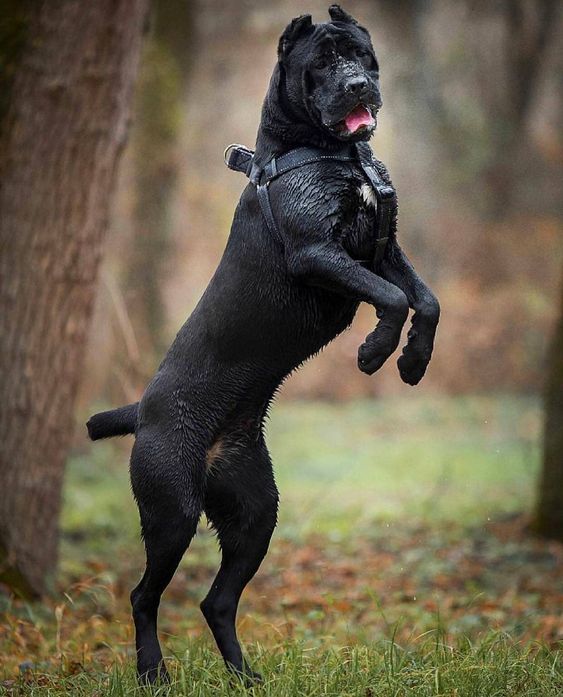
The age-old debate of male versus female takes an interesting turn when it comes to the jumping abilities of Cane Corsos. As guardians of these magnificent creatures, understanding the dynamics between genders can shed light on their unique traits. When it comes to jumping, the distinctions might not be as straightforward as one might think.
Individual Variation
Imagine a spectrum of jumping prowess, with male and female Cane Corsos scattered along its length. The truth is, the ability to jump isn’t solely dictated by gender. It’s a complex interplay of genetics, training, and individual disposition. Picture a scenario where a female Cane Corso effortlessly clears an obstacle that gives a male counterpart pause, or vice versa. It’s a testament to the wide range of jumping capabilities within each gender.
Your male Cane Corso might possess a muscular build that hints at raw power, while your female Cane Corso’s agility might surprise you as she gracefully navigates hurdles. These individual variations remind us that dogs, like humans, are unique beings with their own strengths and challenges.
When pondering the jumping abilities of male and female Cane Corsos. It’s essential to shift our focus from a battle of the sexes to an appreciation of individuality. Picture a scenario where a male and female Cane Corso team up, each bringing their distinctive strengths to the table. It’s a synergy that speaks to the diversity within the breed, a reminder that every dog has their own story to tell through their actions.
In the end, the question of “who jumps higher” becomes secondary to the understanding that each Cane Corso has a jumping style that reflects their own character. In their unique leaps and bounds, they embody the essence of individuality within a breed that’s renowned for its strength and agility.
FAQs
1. Can Cane Corsos jump over standard fences? Yes, Cane Corsos are strong and agile enough to potentially jump over standard fences. Using a taller fence is recommended to prevent this.
2. Are Cane Corsos prone to escaping? Cane Corsos have a tendency to explore and test boundaries, so it’s essential to take measures to prevent escapes.
3. How can I train my Cane Corso not to jump? Obedience training, positive reinforcement, and consistent commands can help train your Cane Corso to avoid jumping.
4. What if my Cane Corso jumps despite training? If your dog continues to jump, consider consulting a professional dog trainer or behaviorist for specialized guidance.
5. Are there specific breeds they may try to chase and jump for? Cane Corsos have a strong prey drive, so they might be more inclined to chase smaller animals, potentially leading to jumping.
6. Can a Cane Corso’s jumping ability be harnessed for agility training? Yes, Cane Corsos can excel in agility training due to their athleticism, but it’s essential to do so under proper supervision and training.
7. Is it better to neuter/spay my Cane Corso to reduce jumping behavior? Neutering/spaying might help reduce certain behaviors but isn’t a guaranteed solution for jumping. Training remains a key factor.
8. How do I make my backyard escape-proof for my Cane Corso? Aside from a tall fence, ensure there are no potential escape routes, and consider creating an engaging environment to reduce the desire to escape.
9. At what age is a Cane Corso’s jumping most problematic? Jumping behavior might be more pronounced during the puppy and adolescent stages. Early training is crucial to manage it effectively.
10. Can I socialize my Cane Corso to reduce jumping when meeting new people? Proper socialization can help reduce overexcitement and jumping when meeting new people, but consistent training is still necessary.
Conclusion
In conclusion, understanding the jumping behavior of Cane Corsos is a vital aspect of responsible pet ownership. These spirited and agile companions possess the ability to leap impressive heights, driven by their curiosity, playfulness, and instinctual nature. By recognizing the reasons behind their jumping tendencies, implementing effective training techniques, and creating suitable physical barriers, we can strike a harmonious balance between their energetic nature and their safety.
With over 4 years of devoted companionship with my beloved Labrador Retriever, Robin, I have cultivated a deep understanding and expertise in all things canine. From training and behavior to health and well-being.

